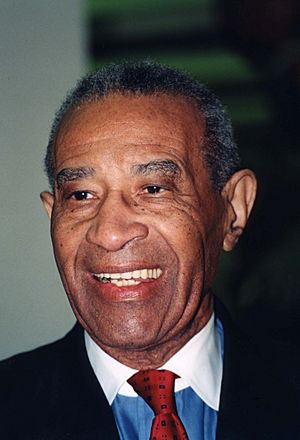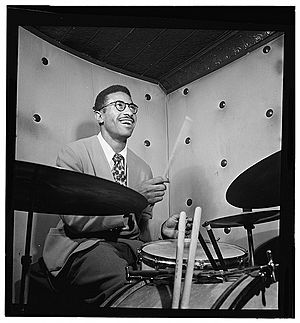Max Roach facts for kids
Quick facts for kids
Max Roach
|
|
|---|---|

Roach in 2000
|
|
| Background information | |
| Birth name | Maxwell Lemuel Roach |
| Born | January 10, 1924 (disputed) Pasquotank County, North Carolina, U.S. |
| Died | August 16, 2007 (aged 83) New York City, U.S. |
| Genres | |
| Occupation(s) |
|
| Instruments |
|
| Years active | 1944–2002 |
| Labels |
|
| Associated acts | |
| Education | Manhattan School of Music |
Maxwell Lemuel Roach (born January 10, 1924 – died August 16, 2007) was an amazing American jazz drummer and composer. He helped create a new style of jazz called bebop. Many people think he was one of the most important drummers ever.
Max Roach worked with many famous jazz musicians. These included Clifford Brown, Charlie Parker, Miles Davis, and Duke Ellington. He was honored in the DownBeat Hall of Fame in 1980. He also joined the Modern Drummer Hall of Fame in 1992.
In the mid-1950s, Roach started a group with trumpeter Clifford Brown. This group was very important in jazz. Later, in 1970, he created M'Boom, a group that played only percussion. Max Roach also used his music to support the Civil Rights Movement.
Contents
Max Roach's Early Life and Music
Max Roach was born in Newland, Pasquotank County, North Carolina. His birth certificate says he was born on January 10, 1924. However, his family believed he was born two days earlier, on January 8.
When he was four, his family moved to Brooklyn, New York. He grew up in a musical home. His mother was a gospel singer. Max started playing the bugle in parades when he was very young. By age 10, he was already playing drums in gospel bands.
Starting His Jazz Career
In 1942, at 18, Max Roach had just finished high school. He got a chance to play with the Duke Ellington Orchestra. This was at the Paramount Theater in New York City. He soon started visiting jazz clubs on 52nd Street. He played with his school friend Cecil Payne. His first professional recording was in December 1943. He played drums for Coleman Hawkins.
Max Roach was one of the first drummers to play in the bebop style. Another pioneer was Kenny Clarke. Roach played in bands led by Dizzy Gillespie and Charlie Parker. He also worked with Thelonious Monk and Miles Davis. He played on many of Parker's most important recordings. These included the 1945 Savoy Records session. This session was a big moment for jazz music.
Roach was also interested in Afro-Caribbean music. In the late 1940s, he traveled to Haiti. There, he studied with a traditional drummer named Ti Roro.
Max Roach in the 1950s
From 1950 to 1953, Max Roach studied classical percussion. He attended the Manhattan School of Music. The school later gave him an honorary degree in 1990.
In 1952, Roach helped start Debut Records with bassist Charles Mingus. This label released a famous concert recording from 1953. It was called "the greatest concert ever" and later known as Jazz at Massey Hall. It featured Parker, Gillespie, Powell, Mingus, and Roach.
The Clifford Brown-Max Roach Quintet
In 1954, Roach and trumpeter Clifford Brown formed a quintet. This group included Harold Land on saxophone and Richie Powell on piano. George Morrow played bass. Later, Sonny Rollins joined the group. This quintet was a great example of the hard bop jazz style.
The Clifford Brown/Max Roach Quintet made some of the best small-group jazz recordings. These recordings are still highly respected today. Roach also recorded with other rising stars. He co-founded Debut, one of the first record labels owned by artists.
In June 1956, Clifford Brown and Richie Powell died in a car accident. This was a very sad time for Roach. The first album he recorded after their deaths was Max Roach + 4. He continued to lead a similar group. Kenny Dorham and later Booker Little played trumpet. George Coleman played tenor saxophone.
Max Roach also played drums for singer Dinah Washington. He performed with her at the Newport Jazz Festival in 1958. This performance was even filmed.
Max Roach in the 1960s and 1970s
In 1960, Max Roach created and recorded the album We Insist!. This album was also called Max Roach's Freedom Now Suite. It featured vocals by his wife at the time, Abbey Lincoln. The lyrics were by Oscar Brown Jr.. This album was part of a celebration for the 100th anniversary of the Emancipation Proclamation.
In 1962, he recorded Money Jungle. This was a collaboration with Charles Mingus and Duke Ellington. Many people consider this one of the best trio albums ever made.
M'Boom and Teaching
During the 1970s, Roach formed M'Boom. This was a special group that played only percussion instruments. Each member wrote music for the group. They played many different percussion instruments.
Max Roach was also very involved in jazz education. In 1972, he became a teacher at the University of Massachusetts Amherst. He taught there until the mid-1990s.
Max Roach in the 1980s and 1990s
In the early 1980s, Max Roach started giving solo concerts. He showed that one person could play many percussion instruments. He created amazing music in these solo shows. One of his solo concerts was even released on video.
Roach also made many duet recordings. He played with artists like Cecil Taylor and Archie Shepp. He even created a duet with the speech "I Have a Dream" by Martin Luther King Jr.. He also performed with his longtime friend, Dizzy Gillespie.
During the 1980s, Roach wrote music for plays. He also created new musical groups. One group was "The Double Quartet." This group combined his regular quartet with "The Uptown String Quartet." His daughter, Maxine Roach, led the string quartet.
Another group was the "So What Brass Quintet." This group had five brass players and Roach on drums. There was no piano or bass. Much of their music was just drums and horn duets.
Max Roach kept finding new ways to express himself through music. He performed a concerto with the Boston Symphony Orchestra. He also performed with dance companies. He even surprised his fans by playing at a hip hop concert. He felt there was a strong connection between young black artists and his own music.
Even with all these new projects, Roach always kept playing jazz. His last recording was Friendship with trumpeter Clark Terry. His final performance was at the 50th anniversary of the original Massey Hall concert. He played a solo on the hi-hat.
Max Roach's Drumming Style
Max Roach's most important changes to drumming happened in the 1940s. He and Kenny Clarke came up with a new way to play time in music. Instead of playing the main beat on the loud bass drum, they played it on the lighter ride cymbal. This made the rhythm more flexible and flowing. It allowed other musicians to play their solos more freely. It also gave the drummer space to add exciting accents on the snare drum and crash cymbal.
Roach matched his drumming with the tune's melody. This brought a new level of expression to the drums. He often changed which part of his drum kit he emphasized. This created different sounds and rhythmic surprises. Roach once said about drummers, "In no other society do they have one person play with all four limbs."
This style is common today, but it was revolutionary in the 1940s. Jazz historian Burt Korall said that when Max Roach's first records came out in 1945, other drummers were amazed and even a little scared. Drummer Stan Levey said, "Because of him, drumming no longer was just time, it was music."
In 1966, Roach released Drums Unlimited. This album had several tracks that were just drum solos. He showed that drums could be a solo instrument. They could play a main theme, variations, and complete musical phrases. Roach said his music was "the creation of organized sound." His style has influenced many jazz and rock drummers.
Honors and Legacy
Max Roach received many awards and honors. He was given a MacArthur Genius Grant in 1988. France made him a Commander of the Ordre des Arts et des Lettres in 1989. He won the French Grand Prix du Disque twice. He was also elected to the International Percussive Art Society's Hall of Fame. He received eight honorary doctorate degrees from different universities.
In 1986, a park in Brixton, London, was named Max Roach Park after him. Max Roach himself opened the park when he visited London that year.
Max Roach spent his later years in Brooklyn. He was honored by the Brooklyn borough president for his musical achievements. In 2009, he was inducted into the North Carolina Music Hall of Fame.
Personal Life
Max Roach had five children: sons Daryl and Raoul, and daughters Maxine, Ayo, and Dara. He was married to singer Abbey Lincoln from 1962 to 1970. She sang on some of his albums.
His godson is the artist and hip-hop pioneer, Fab Five Freddy.
Death
In the early 2000s, Max Roach became less active due to health issues. He passed away on August 16, 2007, in Manhattan. More than 1,900 people attended his funeral. He was buried at the Woodlawn Cemetery in The Bronx.
Discography
As leader/co-leader
|
Co-leader with Clifford Brown
Co-leader with M'Boom
|
As sideman (selected)
With Miles Davis
- Birth of the Cool (Capitol, 1949)
With Duke Ellington
- Money Jungle (United Artists, 1962) also with Charles Mingus
With Dizzy Gillespie
- Diz and Getz (Verve, 1953)
With Thelonious Monk
- Brilliant Corners (Riverside, 1956)
With Charlie Parker
- The Complete Savoy Studio Recordings (1945–48)
- Charlie Parker on Dial (Dial, 1945–48)
With Bud Powell
- The Amazing Bud Powell (Blue Note, 1951)
With Sonny Rollins
- Saxophone Colossus (Prestige, 1956)
- Freedom Suite (Riverside, 1958)
With Dinah Washington
- Dinah Jams (EmArcy, 1954)
Images for kids
See also
 In Spanish: Max Roach para niños
In Spanish: Max Roach para niños




